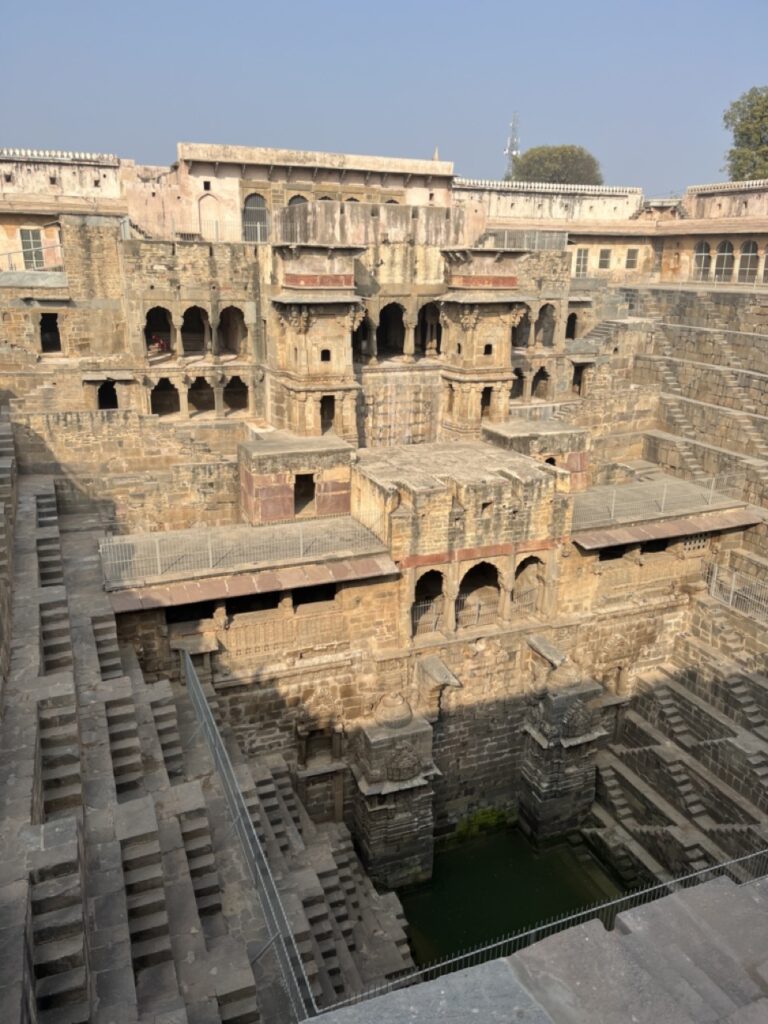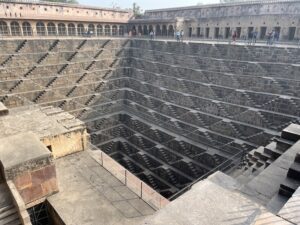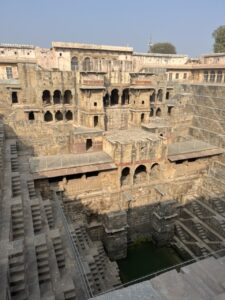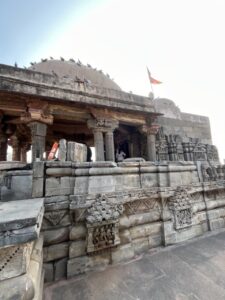The Chand Baori is an ancient stepwell, one of the largest and deepest stepwells in India. I had never heard of the term “stepwell” before, so I didn’t know what to expect. I was looking forward to seeing the stepwell and the temple beside it as they would be the first sights we visited that predated the Mughals.
Stepwells probably started out in ancient times as large wells that villagers could descend into to retrieve water. They were important in places throughout India that suffered wet and dry seasons, so villagers could have dependable access to water throughout the year.
Just like a well, the fresh water comes from underground water. Additionally, stepwells also have the added benefit of being able to collecting rainwater. Between the 9th and 15th centuries, stepwells evolved into highly elaborate architectural and engineering marvels that were not only functional, providing much needed water, but also beautiful. Because the area inside the stepwell can be significantly cooler, five to eight degrees lower than the outside air temperature, they also became places for socializing and holding religious ceremonies. People were naturally drawn to the stepwell and it served as a gathering place for the community, especially for women who were typically responsible for collecting water.
Chand Baori is located in the Abhaneri village, enroute from Agra to Ranthambore National Park. This stepwell dates back to the 8th and 9th centuries when it was built by King Chanda. There are 3,500 steps that lead down to bottom of the well, 20 meters below ground level. When the stepwell was in use, villagers descended the steps to collect water regardless of the water level. The stepwell is no longer in use and when we visited, there was a only bit of water visible at the bottom of the well.
It isn’t until you get quite close to the Chand Baori that you can see the mesmerizing geometric interior of the stepwell. There are 13 stories and countless staircases zig-zagging in a perfectly symmetrical pattern throughout the stepwell. It reminded me of the MC Escher optical illusion drawings where they stairs looked like they were going up and down at the same time. The stepwell becomes narrower as you descend deeper into the well. It made my knees go weak just looking down into the stepwell. I can’t imagine carrying heavy buckets filled with water out of the well.
There are stairs on three sides of the stepwell while the fourth side holds a multi-storied structure with pavilions, balconies and rooms. These rooms were reserved for the royal family to host parties and escape the heat outside in the cooler air of the stepwell.
Just beside Chand Baori is Harshad Mata Temple, a Hindu temple built around the 8th to 9th centuries, dedicated to the goddess Harshat Mata, the goddess of joy and happiness. The temple was largely destroyed by Mahmud Gazni, a Muslim Turk who invaded India numerous times in the 11th century.
Around the temple are piles of ruins that were once part of the temple. What remains today is the inner-most temple that is elevated compared to the rest of the courtyard surrounding it. Other parts of the temple were rebuilt by villagers using the materials they could find nearby. There was a flag flying on the temple, meaning the temple is actively being used for worship.
Author
-

Song is the mother of four children. She and her family have stepped away from it all and in September 2023, began traveling the world while homeschooling. Song is an ABC (American born Chinese) and has an undergraduate degree from Cornell and an MBA from Harvard. She is an entrepreneur and an educator. Her hobbies include learning, traveling, reading, cooking and baking, and being with children.










